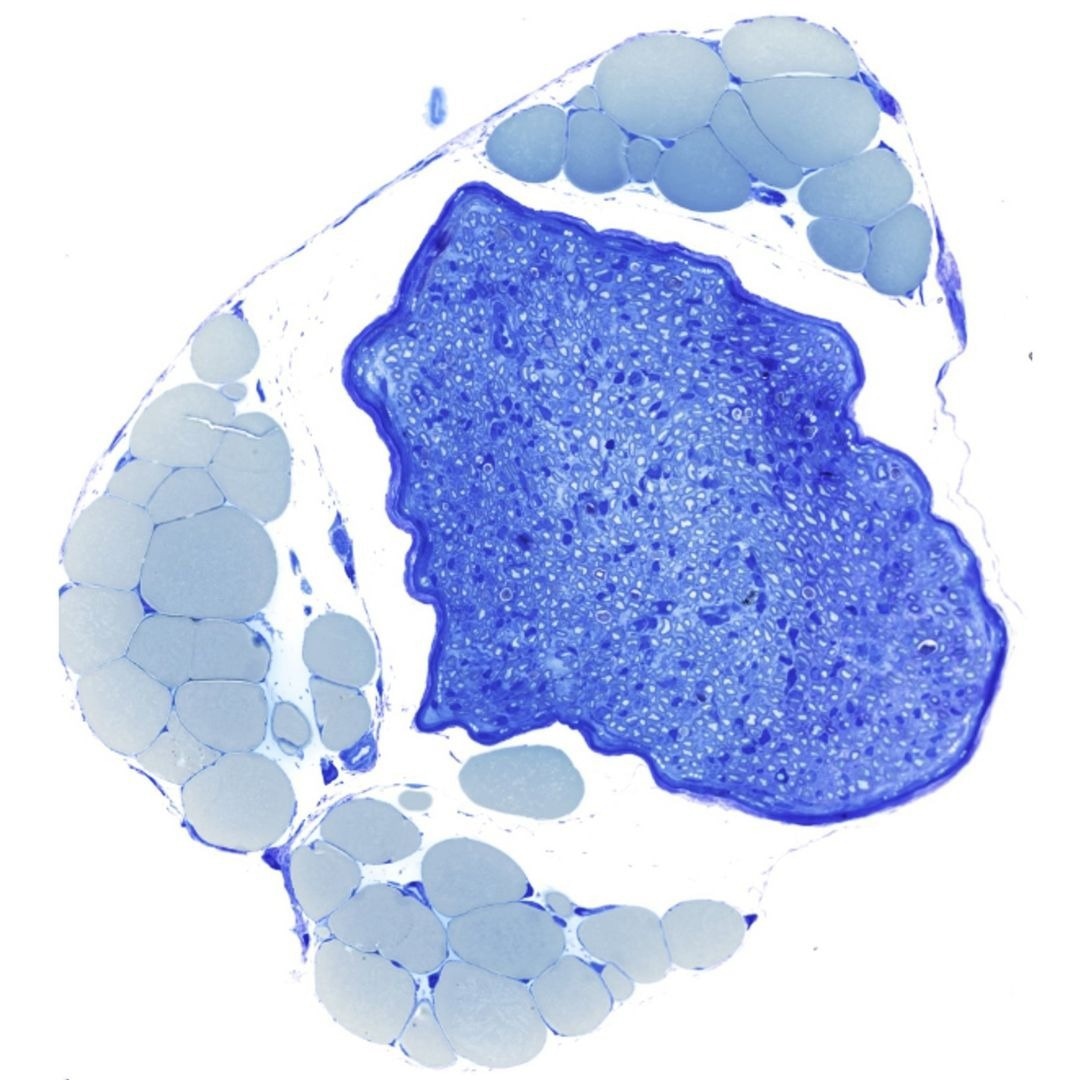Injuries to the peripheral nerves of the body can lead to pain and movement disorders. A recent investigation by Leipzig University delved into enhancing the regeneration of damaged nerves.
 Microscopic cross-section through a peripheral nerve bundle (dark blue), which contains hundreds of nerve fibers coated with Schwann cells. Numerous large fat cells (light blue) can be seen in the vicinity of the nerve. Image Credit: Leipzig University.
Microscopic cross-section through a peripheral nerve bundle (dark blue), which contains hundreds of nerve fibers coated with Schwann cells. Numerous large fat cells (light blue) can be seen in the vicinity of the nerve. Image Credit: Leipzig University.
The study, which was published in Cell Metabolism, revealed that fat tissue significantly supports Schwann cells, which are crucial for the repair process.
The intricate network of nerve fibers coursing through human bodies facilitates the transmission of information, enabling tasks such as muscle control and sensory perception. Peripheral nerves, found in areas like the arms and legs, often sustain damage due to acute injuries, such as accidents.
This damage results in issues like muscle strength loss and sensory problems, including numbness. Although peripheral nerves possess regenerative potential, complete recovery of nerve function remains uncommon, with reasons not yet fully understood.
When a nerve is crushed or severed, the affected nerve fibers initially perish. However, they have the inherent capacity to grow back and fully regenerate, contingent on the role of Schwann cells surrounding the nerve fibers. These cells, vital for coordinating the breakdown and regrowth of nerve fibers in their original areas, play a pivotal role in the repair process.
The metabolic challenges associated with the breakdown and rebuilding of nerve tissue were previously unclear in relation to Schwann cells. Researchers at the University of Leipzig Medical Center have now unveiled that Schwann cells receive crucial support for nerve repair from the surrounding fat tissue.
Using genetically modified mice, the study demonstrated that the chemical messenger leptin, primarily produced by cells in fat tissue and known for its appetite-suppressing effects, plays a key role in facilitating nerve repair by Schwann cells—an unexpected discovery in the context of nerve damage recovery.
“Leptin derived from fat cells stimulates the energy balance of the Schwann cells by activating their mitochondria,” explains Dr. Robert Fledrich from the Institute of Anatomy at Leipzig University and one of the two study leaders.
At the same time, the mitochondria of the Schwann cells use parts of the damaged nerve tissue as an energy substrate so that successful regeneration can take place.”
Ruth Stassart, Study Co-Leader and Professor, Paul Flechsig Institute of Neuropathology, Medical Center, University of Leipzig
Stassart added, “The metabolism of the Schwann cells is therefore optimized for nerve regeneration and significantly promotes the restoration of the original nerve function,” the two researchers explain.
The potential interaction between fat cells and Schwann cells holds promise for exploring novel treatment avenues that could positively impact the metabolic activity of repair cells during nerve damage.
The researchers are optimistic that these newfound insights may contribute to enhancing the regeneration of damaged nerves in humans in the future.
Source:
Journal reference:
Sundaram, V. K., et al. (2023) Adipo-glial signaling mediates metabolic adaptation in peripheral nerve regeneration. Cell Metabolism. doi.org/10.1016/j.cmet.2023.10.017.